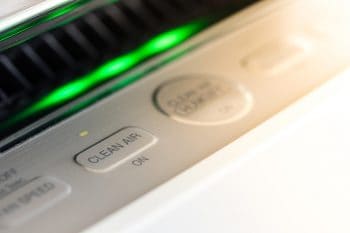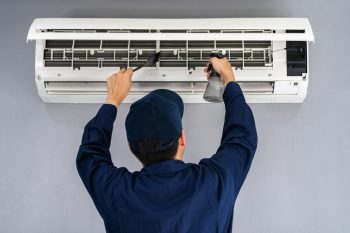
Whether you’re moving into a new house or shifting your washing machine from one room to another, pulling out a washing machine is a daunting process.
However, with Appliance Teacher, it is not because we’re here to give you the best way to pull out a washing machine.
Since most washing machines lack wheels and are quite hefty, therefore, the person’s back who’s moving and the floor should be protected.
You can easily remove a washing machine by opening the door and grabbing the top of the door seal. The washing machine should then be raised and pulled forward.
The washing machine should be slightly tipped back before pulling it out to ensure that the feet are not affixed to the floor.
However, if you have back pain, we highly suggest refraining from this task.
If the door doesn’t open because of a malfunction, you can try removing the soap drawer or lifting the front part of the machine from below to gain traction and open it.
Besides this, if your washing machine is positioned beneath a kitchen worktop, ensure its back feet do not snag on the floor.
Or if they are going below the floor covering, you should try leaning the machine forward so that it is standing on its front feet. If you don’t, it will tear the floor covering.
Or if they are going below the floor covering, you should lean the machine forward so that it is standing on its front feet. If you don’t, it will tear the floor covering.
6 Steps To Pull Out a Washing Machine
With these 6 steps, you’re all sorted for pulling out your washing machine. So, stick to these whenever you intend to pill out a washing machine:
Use an old towel under the feet to protect the flooring. Doing so will make the whole process a breeze.
Besides this, you can also use a trolley to move your washer from one room to another.
1. Preparing the Washing Machine
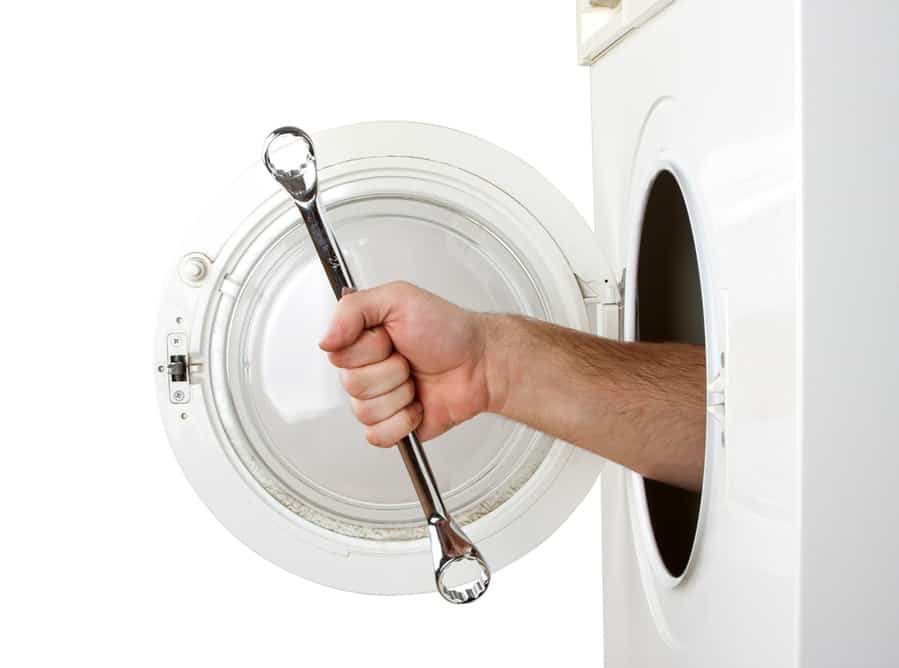
Preparing your washing machine for the move is the primary step of this DIY process. Therefore, take the following precautions carefully before pulling out your washing machine.
You will need some small metal rods, known as shipping bolts, transit bolts, or washer locks.
Then place them into certain slots underneath your washing machine. It maintains the drum stable and immobile during the whole process.
Without transit bolts, moving your washer poses a significant risk since vibrations and quick jerks can harm the drum suspension systems.
On the other hand, if you plan to move out, you will need an appliance dolly to move your washing machine from home to a moving vehicle.
On average, a washing machine weighs 140-230 lbs. So, unless you’re a powerlifter, you’ll need an appliance dolly to pull off this move successfully.
Only try to pull out your washing machines using transit bolts. These are so important to keep your drum in place. If you do so, your washer might experience significant damage.
These bolts usually come with a washing machine. However, if you’re looking for them, you can easily find them from your washer’s manufacturer or a nearby home appliance shop.
2. Drain Your Washing Machine and Disconnect It
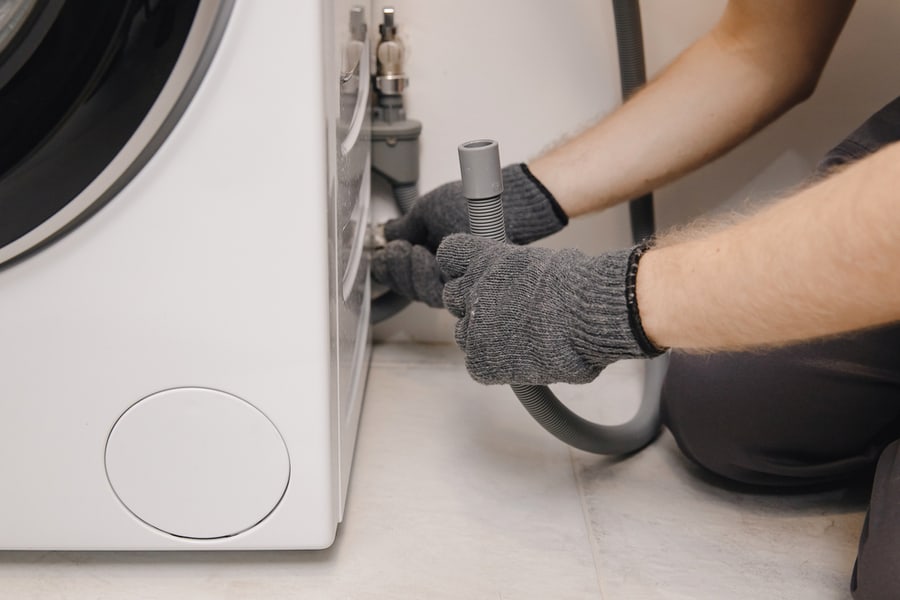
To ensure you have no plumbing mishaps when placing your washer again, here’s what you need to do:
- Verify that the washer is empty. Look for loose or stray bits of clothes.
- Use a pack of cleanser or bleach to thoroughly clean your washing machine by running it through one wash cycle. This removes detergent residue from the washing machine’s drum and drains pipe.
- When you use the washing machine, open the door or lid so the inside can dry completely.
- Disconnect your computer from the power grid. You won’t have a chance of being shocked or electrocuted because of this.
- After that, stop the water supply. Most washers only require a simple clockwise rotation of a valve. Be careful not to jar anything loose when tugging on the washer to gain access to the water supply valve.
- Unplug the water valve’s supply hose using your slip joint pliers. A pail or basin should be prepared to capture any extra water that may drip from the hose. After all, you wouldn’t want to create a mess!
- While relocating the unit, keep the washer’s drain hose connected.
3. Safeguard the Washing Machine
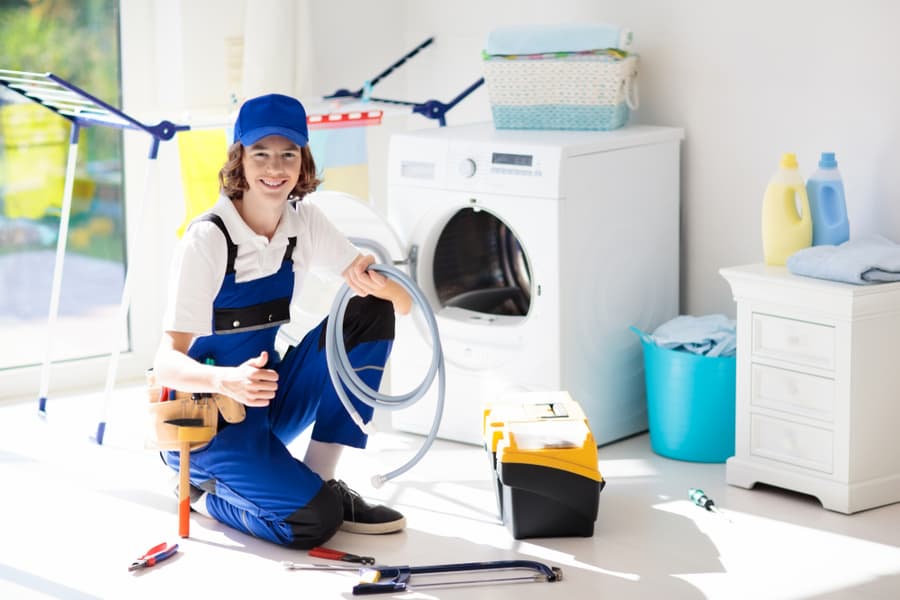
When you’ve gathered your necessary tools and drained your washer, it’s time to safeguard it. Here’s how you can do that:
- Fasten the transit bolts to the washing machine’s backside. This should prepare the drum or tub for travel by securing it within the washing machine.
- The process of inserting the bolt ought to be relatively uncomplicated, despite the possibility that it varies from one model of a washing machine to another. Therefore, consult your user handbook for safety.
- To make sure it won’t get in the way while pulling, roll up the electrical cord of your washing machine and tape it to the back of the appliance with duct tape or packing tape.
- Protect your washing machine by wrapping it in moving or laundry blankets. Use tape to affix these blankets. Doing this will shield the surface of your washer from any dings or scratches it might get in transit.
4. Pulling Out

Now you’ve done all the necessary steps, it’s time for the showdown. However, before pulling your washing machine, ensure the feet are not anchored to the floor before moving the machine forward.
On a hard surface, this is not important, but if you get the feet trapped and try to drag the washing forward, you’ll probably rip the flooring.
To start, raise it from the front, so the front feet are tethered to the ground. Keeping the washer’s door open and your hands at its ape, lift it.
Tip the machine forward to check if the back feet are stuck or to release them.
Frequently, the floor covering ends just beneath the washer. This occurs when the installer is either too lazy or unaware of the necessity to fit it completely under.
Since most washers sit on a countertop, it can be difficult to tell if the flooring continues to the wall. If it doesn’t, the back feet will probably catch on the ground when you move it forward.
5. Get an Appliance Dolly

You can skip this part if you only intend to clean the surface and not move. But if you’re planning to move, you should buy or rent an appliance dolly after pulling out your washing machine.
Given the weight of the washing machine, you must understand that you cannot lift and move household appliances with your hands alone. It’s not feasible!
Therefore, to efficiently and securely move the heavy object from your existing residence to the moving van and your new home, you’ll need to invest in a moving dolly.
6. Look at Your Washer’s Manual

After significant appliances are removed from their packaging, owner’s manuals or user instructions are frequently disregarded. But we often misplace it.
However, fret not, as if you’ve lost the instructions for your washing machine, you can probably get a copy of the handbook online.
If your washer’s user guide is unavailable online, you might try contacting the manufacturer or retailer from which you bought the machine.
In these situations, referring to your washing machine’s manual is important since manufacturers occasionally suggest moving the machine.
Tips on Moving a Washing Machine
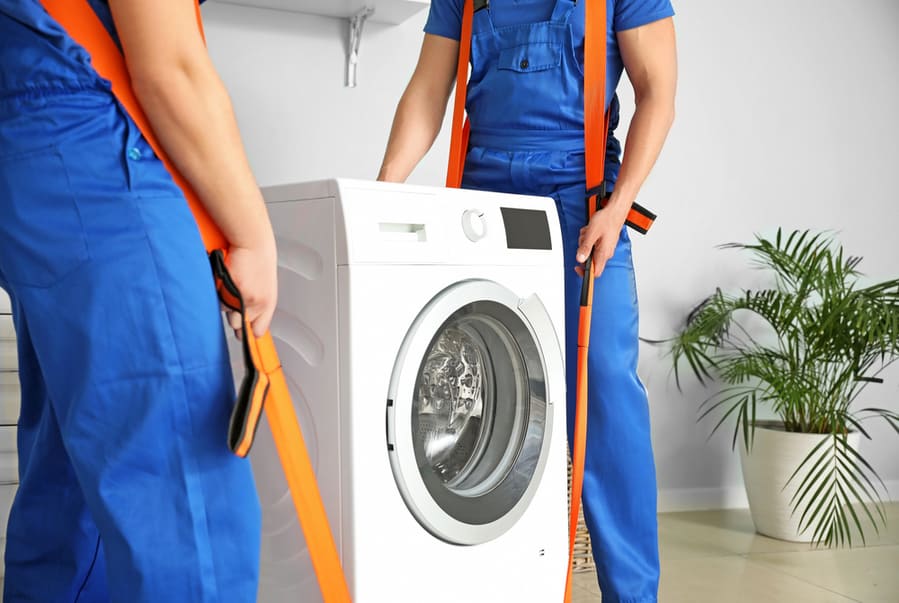
If you don’t want to hire a moving company, there are safe and effective ways to move your machine. Here are some of the top tricks and advice:
- Avoid damaging your floors by hiring or purchasing a trolley to transfer your washing machine. Buy or rent a trolley with wheels to get your major appliances from home to the moving truck.
- Clean the machine thoroughly before moving: It’s a good idea to clean it thoroughly. As a result, the equipment is kept clean and free of dirt and debris. Additionally, it lessens the likelihood that mold and mildew will form while you are relocating.
- Please close the door firmly and tie it securely with a rope or package thread. The door is readily broken if something swings open and lands on it. You can use bubble wrap to add a layer of protection to the door.
- Take advantage of the transit bolts; even though getting new ones can be inconvenient if you’ve misplaced them, you mustn’t do it. We advise purchasing the bolts because vibrations can harm your washing machine during transportation.
- Ensure the machine stands straight when transporting or putting it away in the moving vehicle. This safeguards your device and ensures no extra dirt or water enters the motor.
- Use styrofoam and bubble wrap cushions for your washing machine during shipping; if you can, repeat that. To prevent dents and scratches on the machine, wrap it in heavy blankets if you can’t access these tools.
Conclusion
The best way to pull out a washing machine is to grab it by the door and pull it out. However, take care not to damage your washing machine as you move it from one location to another.
So, if you want to clean the surface or move, use our instructions to avoid making mistakes at the last minute. Last but not least, before pulling out, make sure the machine is always unplugged.
Frequently Asked Questions
How Can I Remove Washing Machine Without Harming the Floor?
You can do this by leaning the appliance back enough to fit a piece of carpet or thick cardboard between the front legs and as close as you can to the back legs.
Then, move the appliance forward, so the back legs rest on the cardboard.
Can One Person Move a Washer?
No, always have a helper on hand when lifting the washing machine because it takes two people. If you’re doing it all alone, there are chances of hurting your back.




